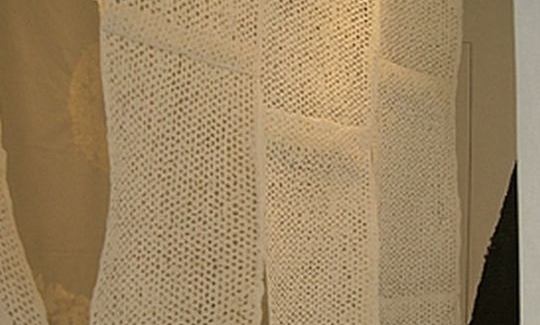The contemporary artist Kumagai Masa creates installations out of handmade Japanese paper. In her "Gateless Gate", paper cylinders are suspended inside a rectangular construction, on one side of which there is a narrow window, and on the other a small, low entrance.
Kumagai uses various types of paper of different textures - transparent, opaque, white or black. The paper strips of different lengths hang down from the "ceiling" in clusters. Each cluster comprises both black and white paper intertwined with wire, and with delicate Japanese gampi papers on which there is a kind of collage and printing. Another type of Japanese paper of a different length hangs among them. The transparency of the paper depends on the closeness of the weave. The intention of combining the various types of paper is to convey the relationship of light with dark, interior with exterior. Kumagai also wants us to sense the beauty of the light penetrating the layers of paper.
In fact, in her creations, Kumagai has been trying to cope with new challenges, expending years of effort in the preparation of strips of paper from fragile fibres. Thus she uses the simplest of means - paper - in order to deal with concepts of space, the void and, most complex of all, existence in the modern world.
The title of the exhibition "The Gateless Gate" (Mumonkan) is that of a book by the Chinese Zen Master Mumon who lived in the 12th century. We usually think of a gate as the entrance to a specific place. A gateless gate should thus be either an entrance or a barrier. The meaning of "gateless" is that there is no gate at the barrier through which to enter; or that there is no barrier at the gsteway. It all depends on the interpretation of the viewer standing in front of the little low entry to Kumagai's work. This opening is reminiscent of the entrance to the traditional Japanese tea-room. The intention of that low entrance, as it is in the installation, is to make whoever enters bend down. In the tea-room, hands and feet are in contact with the natural substance of the tatami mats, involving the sense of touch in the whole experience. Bending, like bowing, is an expression of humility, modesty, respect for both the event and for the simple natural materials of which the entire room is made. Kumagai is trying to remind the spectator of the respect we should show for the natural world that surrounds and supports us. Nature is embodied in the fibres of the trees from which the sheets of paper are made. In a period rife with discussions concerning pollution of the air and of the natural environment, the despoiling of forests and global warming, perhaps Kumagai wants us to remember that we are just as fragile as the natural material - paper - a product that is taken for granted in our world.
Modern city life has put us out of touch with nature. As Mumon declared: "The route is close at hand, but you are searching for it in the distance." When we understand that the "gateway" to our existence is nature, and not our own self-awareness, the gateless gate will open for us.


